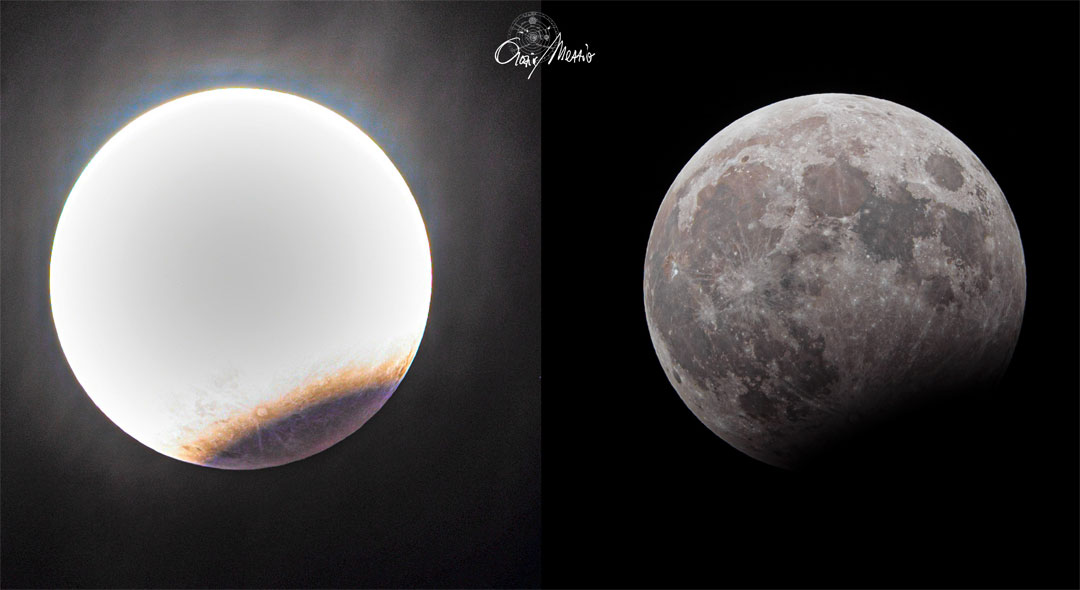29. October 2023
月偏食

探索宇宙1!逐工會揀一幅無仝款 ê 影像抑是相片,𤆬你熟似咱這个迷人 ê 宇宙,閣有專業天文學者2為你解說3。
- 原始文章:A Partial Lunar Eclipse
- 影像來源 kah 版權:Orazio Mezzio
- 相簿:投稿到 APOD ê 月偏食精選相片
- 台文翻譯:An-Li Tsai (NSYSU)
[漢羅] 月偏食
月娘是發生啥物代誌? 昨昏有一部份月球行到 地球烏影 下底。 這毋是逐個月攏有,一年會發生一擺到兩擺,因為月球踅地球 ê 軌道 有小可仔趨一个角度。 這張相片是 拍獵月,是秋分了後 ê 第二擺月圓,伊 tī 意大利 發生 月偏食 ê 時陣,會出現 2 擺。 倒爿 ê 月娘大部份攏 過度 感光 矣,伊 ùi 正爿下底開始發生月食,tī 遮有出現咱熟似–ê 月球表面。 正爿是仝一粒 月娘,kah 伊相比,月球是正常感光,毋過正爿下底是暗–ê。 地球 向月球彼半爿頂懸 ê 人攏看會著 各種月食。 天頂 若是無雲,歐洲、非洲、亞洲、kah 澳洲,攏會當 看著 這擺 ê 月食。 北美洲 會 tī 4 月 ê 時陣看著 日全食。
[POJ] Goe̍h-phian-si̍t
Goe̍h-niû sī hoat-seng siáⁿ-mih tāi-chì? Cha-hng ū chi̍t-pō͘-hūn Goe̍h-kiû kiâⁿ kàu Tē-kiû o͘-iáⁿ ē-té. Che m̄-sī ta̍k kò goe̍h lóng-ū, chi̍t-nî ē hoat-seng chi̍t-pái kàu nn̄g pái, in-ūi goe̍h-kiû se̍h Tē-kiû ê kúi-tō ū sió-khóa-á chhu chi̍t-ê kak-tō͘. Chit-tiuⁿ siòng-phìⁿ sī Phah-la̍h-goe̍h, sī chhiu-hun liáu-āu ê tē-jī pái goe̍h-îⁿ, i tī I-tá-lī hoat-seng goe̍h-phian-si̍t ê sî-chūn, ē chhut-hiān 2 pái. Tò-pêng ê goe̍h-niû tōa-pō͘-hūn lóng kòe-tō͘ kám-kng–ah, i ùi chiàⁿ-pêng ē-té khai-sí hoat-seng goe̍h-si̍t, tī chia ū chhut-hiān lán se̍k-sāi–ê Goe̍h-kiû piáu-bīn. Chiàⁿ-pêng sī kāng chi̍t-lia̍p goe̍h-niû, kah i sio-pí, Goe̍h-kiû sī chèng-siông kám-kng, m̄-koh chiàⁿ-pêng ē-té sī àm–ê. Tē-kiû hiòng goe̍h-kiû hit pòaⁿ-pêng téng-koân ê lâng lóng khòaⁿ-ē-tio̍h kok-chióng goe̍h-si̍t. Thiⁿ-téng nā-sī bô hûn, Au-chiu, Hui-chiu, A-chiu, kah Ò-chiu, lóng ē-tàng khòaⁿ-tio̍h chit pái ê goe̍h-si̍t. Pak-bí-chiu ē tī 4 goe̍h ê sî-chūn khòaⁿ-tio̍h ji̍t-choân-si̍t.
[KIP] Gue̍h-phian-si̍t
Gue̍h-niû sī huat-sing siánn-mih tāi-tsì? Tsa-hng ū tsi̍t-pōo-hūn Gue̍h-kiû kiânn kàu Tē-kiû oo-iánn ē-té. Tse m̄-sī ta̍k kò gue̍h lóng-ū, tsi̍t-nî ē huat-sing tsi̍t-pái kàu nn̄g pái, in-uī gue̍h-kiû se̍h Tē-kiû ê kuí-tō ū sió-khuá-á tshu tsi̍t-ê kak-tōo. Tsit-tiunn siòng-phìnn sī Phah-la̍h-gue̍h, sī tshiu-hun liáu-āu ê tē-jī pái gue̍h-înn, i tī I-tá-lī huat-sing gue̍h-phian-si̍t ê sî-tsūn, ē tshut-hiān 2 pái. Tò-pîng ê gue̍h-niû tuā-pōo-hūn lóng kuè-tōo kám-kng–ah, i uì tsiànn-pîng ē-té khai-sí huat-sing gue̍h-si̍t, tī tsia ū tshut-hiān lán si̍k-sāi–ê Gue̍h-kiû piáu-bīn. Tsiànn-pîng sī kāng tsi̍t-lia̍p gue̍h-niû, kah i sio-pí, Gue̍h-kiû sī tsìng-siông kám-kng, m̄-koh tsiànn-pîng ē-té sī àm–ê. Tē-kiû hiòng gue̍h-kiû hit puànn-pîng tíng-kuân ê lâng lóng khuànn-ē-tio̍h kok-tsióng gue̍h-si̍t. Thinn-tíng nā-sī bô hûn, Au-tsiu, Hui-tsiu, A-tsiu, kah Ò-tsiu, lóng ē-tàng khuànn-tio̍h tsit pái ê gue̍h-si̍t. Pak-bí-tsiu ē tī 4 gue̍h ê sî-tsūn khuànn-tio̍h ji̍t-tsuân-si̍t.
[English] A Partial Lunar Eclipse
What’s happened to the Moon? Within the last day, part of the Moon moved through the Earth’s shadow. This happens about once or twice a year, but not every month since the Moon’s orbit around the Earth is slightly tilted. Pictured here, the face of a full Hunter’s Moon is shown twice from Italy during this partial lunar eclipse. On the left, most of the Moon appears overexposed except for the eclipsed bottom right, which shows some familiar lunar surface details. In contrast, on the right, most of the (same) Moon appears normally exposed, with the exception of the bottom right, which now appears dark. All lunar eclipses are visible from the half of the Earth facing the Moon at the time of the eclipse, but this eclipse was visible specifically from Europe, Africa, Asia, and Australia, clouds permitting. In April, a total solar eclipse will be visible from North America.
詞彙學習(漢羅/POJ/KIP/華語/English)
- 【月偏食】goe̍h-phian-si̍t/gue̍h-phian-si̍t/月偏食/partial lunar eclipse
- 【月食】goe̍h-si̍t/gue̍h-si̍t/月食/lunar eclipse
- 【日全食】ji̍t-choân-si̍t/ji̍t-tsuân-si̍t/日全食/total solar eclipse
- 【拍獵月】Phah-la̍h-goe̍h/Phah-la̍h-gue̍h/獵月/Hunter’s Moon
- 【過度感光】kòe-tō͘ kám-kng/kuè-tōo kám-kng/過度曝光/overexpose